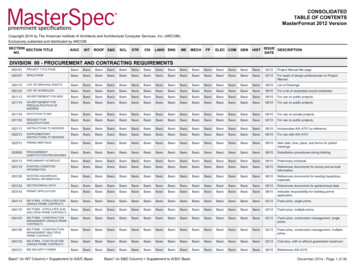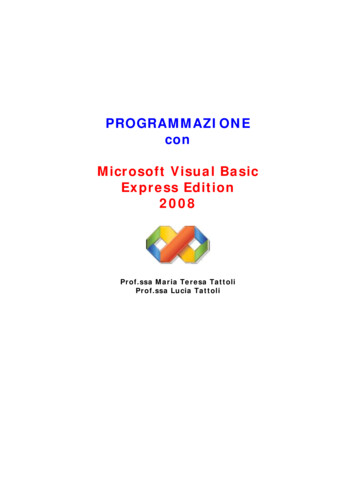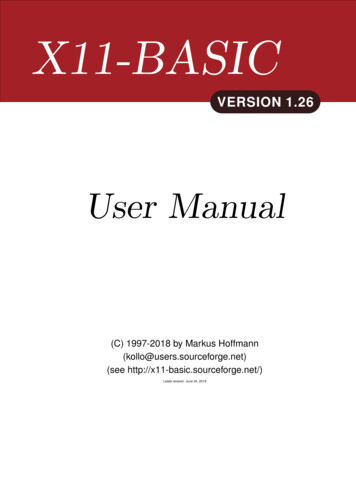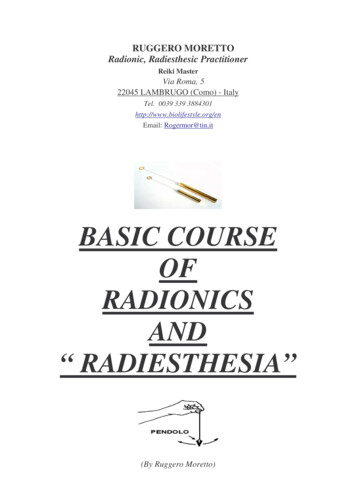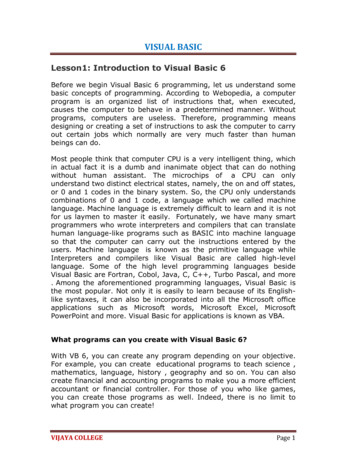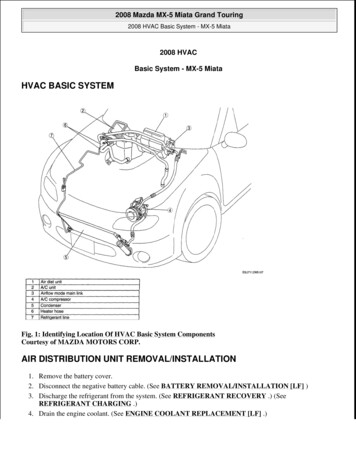
Transcription
LESSON NOTESBasic Bootcamp #1Self Introduction: Basic Greetingsin le SentencesVocabulary Phrase UsageGrammarCultural Insight#COPYRIGHT 2012 INNOVATIVE LANGUAGE LEARNING. ALL RIGHTS RESERVED.1
FINNISH1.Sari:Hei, Minun nimeni on Sari, mikä sinun nimesi on?2.Mary:Hei Sari, minun nimeni on Mary.3.Sari:Hauska tutustua.4.Mary:Kiitos samoin.ENGLISH1.Sari:Hello. My name is Sari. What's your name?2.Mary:Hello Sari. My name is Mary.3.Sari:Nice to meet you.4.Mary:Me too.VOCABULARYFinnishEnglishC uska tutustua.Nice to meet you.expressionollato beverbKiitos samoin.Thanks, you too.expressionMinun nimeni onMy name isphraseSAMPLE SENTENCESFINNISHPOD101.COMBASIC BOOTCAMP #1 - SELF INTRODUCTION: BASIC GREETINGS IN FINNISH2
Hei, Mari.Minun nimeni on Mikko."Hello, Mari.""My name is Mikko."Kenen nimellä varaus on?Hauska tutustua, Mari."Whose name is the reservationunder?""Nice to meet you, Mari."Onko sinulla siskoa?"Hauska tutustua." "Kiitos,samoin.""Do you have a sister?""Nice to meet you." "You too."Minun nimeni on Reeta."My name is Reeta."VOCABULARY PHRASE USAGENimeni and nimesiNimeni and nimesi should not be confused with each other. Nimeni is " my name,"with the -ni ending as a possessive suffix. It is added to every noun when talkingabout possession in first person singular. Nimesi instead means "your name," andthe -si suffix is a possessive suffix added to nouns when talking about possessionin second person singular. You can notice the change of an -I in nimi to an -e beforethe suffix. This is a peculiarity of Finnish language when adding suffixes to words.For Example:1.2.Minun nimeni -."My name -."Sinun nimesi on Mikko."Your name is Mikko."HauskaHauska is like the English word "fun." However, don't confuse it with kiva, whichmeans "nice." Both can be used for the same purpose in the phrase "Nice to meetyou," which can be said hauska tavata or kiva tavata, but hauska implies a moreFINNISHPOD101.COMBASIC BOOTCAMP #1 - SELF INTRODUCTION: BASIC GREETINGS IN FINNISH3
formal meaning.Kiitos samoinKiitos samoin literally means "thank you, you too" (or "the same way"). It has onlyone specific use, and that is to formally reply that you say the same as the otherperson, as the English phrases "me too," or "with the same intention."For Example:1.2.Onnea kokeeseen."Good luck with the exam."Kiitos samoin."Thank you, you too." (Assuming both have exams)GRAMMARThe Focus of This Lesson Is How to Ask Somebody their Name.To ask someone their name, just ask Mikä sinun nimesi on? Literally, this means"What is your name?"The first word, mikä, means "what." It is followed by sinun nimesi which is the noun"your name" and the verb for "is", "on."Mikä sinun nimesi on? With this question, you'll be able to meet people easily inFinland.CULTURAL INSIGHTGreeting a Finnish PersonWhen meeting someone for the first time in Finland, it is customary for men andwomen to shake hands when introducing themselves. This will be sufficient for allformal situations and is definitely the best strategy for business situations.Once you become friends with Finns, however, it is customary for women to hug,and for men to tap each other on the shoulders and shake hands. Sometimes yousee men and women hugging each other, or even male friends hugging each other.Finns can be quite friendly once they get to know somebody.FINNISHPOD101.COMBASIC BOOTCAMP #1 - SELF INTRODUCTION: BASIC GREETINGS IN FINNISH4
LESSON NOTESBasic Bootcamp #2Talking Nationality in le SentencesVocabulary Phrase UsageGrammarCultural Insight#COPYRIGHT 2012 INNOVATIVE LANGUAGE LEARNING. ALL RIGHTS RESERVED.2
FINNISH1.Sari:Hei. Minun nimeni on Sari. Olen suomalainen.2.Mary:Hei, olen Mary. Olen brittiläinen.ENGLISH1.Sari:Hello. My name is Sari. I'm Finnish.2.Mary:Hello, I'm Mary. I'm British.VOCABULARYFinnishEnglishC lasssuomalainenFinnish (nationality)nounbrittiläinenBritish (nationality)nounMinä olenI am/I'mpronounniminamenounminunmypronounSAMPLE SENTENCESMinä olen suomalainen.Minä olen brittiläinen."I'm Finnish.""I'm British."Minä olen Sara.Kenen nimellä varaus on?"I'm Sara.""Whose name is the reservationunder?"FINNISHPOD101.COMBASIC BOOTCAMP #2 - TALKING NATIONALITY IN FINNISH2
Minun nimeni on Mikko."My name is Mikko."VOCABULARY PHRASE USAGETo say you are a certain nationality, just say the phrase Minä olen, which means "Iam," and add brittiläinen after it, which means "I am British." To change nationalityto, say, Russian, use the same minä olen and just add the word for Russian at theend to form minä olen venäläinen.GRAMMARThe Focus of This Lesson Is to Teach You How to Talk About NationalityLet's take a look at the dialog again.Maria: Hei, minä olen Mari. Olen brittiläinen.We start with a self-introduction ("Hello, my name is Mikko"). Then we say ournationality using the phrase olen venäläinen.Here are some examples:Finnish"English"Olen suomalainen"I'm Finnish."Olen venäläinen"I'm Russian."Hän on amerikkalainen"He's American."Hän on brittiläinen"She is British"Oletko sinä japanilainen"Are you Japanese?"Oletko sinä kiinalainen"Are you Chinese?"Minun tyttöystäväni on ranskalainen."My girlfriend is French."Minun poikaystäväni on italialainen."My boyfriend is Italian."CULTURAL INSIGHTFINNISHPOD101.COMBASIC BOOTCAMP #2 - TALKING NATIONALITY IN FINNISH3
Why Study Finnish?Finland is a popular tourist destination, and knowledge of Finnish will help youmake the most of any visit there. For history buffs, Finnish is a member of Finniclanguages and the Finno-Ugric group of languages. Understanding Finnish will helpopen up less well-known, but nevertheless fascinating aspects of NorthernEuropean culture. It's also great just to be able to order some delicious Finnishfood using only Finnish.FINNISHPOD101.COMBASIC BOOTCAMP #2 - TALKING NATIONALITY IN FINNISH4
LESSON NOTESBasic Bootcamp #3Useful Phrases for Learning le SentencesVocabulary Phrase UsageGrammarCultural Insight#COPYRIGHT 2012 INNOVATIVE LANGUAGE LEARNING. ALL RIGHTS RESERVED.3
FINNISH1.A:Anteeksi, miten sanotaan “cheese” suomeksi?2.B:Juusto3.A:Anteeksi, en ymmärrä. Voisitko sanoa sen uudestaan?4.B:Juusto5.A:Voisitko sanoa sen hitaammin.6.B:Juus-to7.A:Voisitko kirjoittaa sen minulle suomeksi?ENGLISH1.A:Excuse me, how do you say "Cheese" in Finnish?2.B:Cheese.3.A:I'm sorry, I didn't understand. Say it once again, please.4.B:Cheese.5.A:Please, speak slower.6.B:Chee-se.7.A:Write this down in Finnish for me, please.VOCABULARYFINNISHPOD101.COMBASIC BOOTCAMP #3 - USEFUL PHRASES FOR LEARNING FINNISH2
FinnishEnglishC lassAnteeksi.Pardon me. Excuse me.expressionvähäna bit, a little, a fewadverbmitenhow, what aadverbsanoato say, to tellverbymmärtääto understandverbeinot, does not/do notconjunctionsuomeksiin Finnishadjectiveseitpronounvoidato be able toverbuudestaanonce morephrasehitaamminmore slowlyadverbkirjoittaato writeverbminullefor mepronounSAMPLE SENTENCESAnteeksi, olen myöhässä.Saisinko vähän teetä?"Excuse me for being late.""May I have a little tea, please?"Minulla on vähän päänsärkyä.Miten pian tulet kotiin?"I have a bit of a headache.""How soon will you come home?"Miten voit?Älä sano mitään."How are you doing?""Don’t say anything."Voisitko sanoa missä on hotelli?Kun joku aivastaa, sanotaan"Terveydeksi.""Could you tell me where the hotelis?"FINNISHPOD101.COM"When somebody sneezes, we say,'Bless you.'"BASIC BOOTCAMP #3 - USEFUL PHRASES FOR LEARNING FINNISH3
Mitä hän sanoo?Ymmärrän mitä olet sanomassa."What is he/she saying?""I understand what you are saying."Voi, tämä ei ole hyvää.Anteeksi, miten sanotaan"cheese" suomeksi?"Oh, this is not good."Se on huhtikuun 15.(viidestoista) päivä."It's April 15th.""Excuse me, how do you say'cheese' in Finnish?"Kyllä, se on aika hyvää."Yes, it's quite good."Voisitko sanoa sen uudestaan?Voisitko korjata sen minulle?"Could you say it once again?""Could you repair it for me?"Voinko katsoa tätä kuvaa?Sanon sen uudestaan."Can I look at this picture?""I'll say it again."Aja hitaammin, kiitos!En osaa kirjoittaa suomeksi."Drive slower, please!"“I can’t write in Finnish.”Voitko tuoda minulle hampurilaisen?“Can you bring me a burger?”VOCABULARY PHRASE USAGEAnteeksi means "excuse me" and has the same usage as in English when used inquestions. However, if we use it in an interrogative sentence, the meaning ofanteeksi will change to "I'm sorry."For Example:1.Anteeksi, mitä kello on nyt?"Excuse me, what time is it now?"FINNISHPOD101.COMBASIC BOOTCAMP #3 - USEFUL PHRASES FOR LEARNING FINNISH4
Anteeksi, en huomannut sinua."I'm sorry, I didn't notice you."2.Anteeksi, missä on vessa?Excuse me, where is the toilet?3.Vähän hitaammin, kiitos.We don't mention "to speak" as this is automatically understood from the context inthe conversation. In other words, the meaning of this phrase depends on thecontext.For example:1.Ajat liian nopeasti! Aja vähän hitaammin, kiitos."You're driving too fast! Drive a bit more slowly please."Vähän hitaammin means "a bit slower." If you have difficulty understanding yourcompanion, you can simply say this.1.Hitaammin, kiitos."Slower, please."Voitko kirjoittaa sen minulle?Again, this is understood by its context. The sentence by itself simply prompts thelistener to write something ("that") for you. If you want to specify the language, youadd the language you want it written down in and at the end of the language youadd the suffix -ksi. Suomeksi, englanniksi. Notice that there might be some changesat the end of the word or in the middle.For example:1.Voitko kirjoittaa sen minulle suomeksi?"Can you write that down in Finnish for me, please?"GRAMMARThe Focus of This Lesson is Using Finnish Phrases to Learn MoreFinnishFINNISHPOD101.COMBASIC BOOTCAMP #3 - USEFUL PHRASES FOR LEARNING FINNISH5
Our first phrase was: Anteeksi, miten sanotaan suomeksi. Anteeksi("Excuse me")The first word in this sentence means "excuse me" and has the same usage as inEnglish when used in questions. However, if we use it in an interrogative sentence,the meaning of anteeksi will change to "I'm sorry."For Example:Anteeksi, miten sanotaan suomeksi ("How do you say inFinnish?")Miten sanotaan literally means "How is said." We can translate suomeksi as "inFinnish," and it refers to the language in our case.CULTURAL INSIGHTGive it your Best Shot!Finns really appreciate any effort to speak their language rather than watching yetanother tourist try to get by with just English. The phrases introduced in this lessonwill demonstrate a real earnestness to study the language, which will strengthen apositive impression and can help you make friends.What's more, sticking with Finns as much as possible will help you get access tosome of the lesser-known, and more interesting, spots that you won't find inEnglish-language guidebooks. Using Finnish can really open up Finland, and nothingbeats an immersion experience when it comes to providing new perspectives ontravel and on life.FINNISHPOD101.COMBASIC BOOTCAMP #3 - USEFUL PHRASES FOR LEARNING FINNISH6
LESSON NOTESBasic Bootcamp #4Counting from 1-100 in le SentencesVocabulary Phrase UsageGrammarCultural Insight#COPYRIGHT 2012 INNOVATIVE LANGUAGE LEARNING. ALL RIGHTS RESERVED.4
FINNISH1.A:yksi (1),2.B:ja3.A:kaksi (2)4.B:ja5.A:kolme (3)6.B:ja7.A:neljä (4)8.B:ja9.A:viisi (5)10.B:ja11.A:kuusi (6)12.B:ja13.A:seitsemän (7)14.B:ja15.A:kahdeksan (8)16.B:jaCONT'D OVERFINNISHPOD101.COMBASIC BOOTCAMP #4 - COUNTING FROM 1-100 IN FINNISH2
17.A:yhdeksän (9)18.B:ja19.A:kymmenen 2.B:AndCONT'D OVERFINNISHPOD101.COMBASIC BOOTCAMP #4 - COUNTING FROM 1-100 IN FINNISH3
.B:And19.A:tenVOCABULARYFinnishEnglishC E SENTENCESFINNISHPOD101.COMBASIC BOOTCAMP #4 - COUNTING FROM 1-100 IN FINNISH4
Kykloopilla on yksi silmä.Minulla on yksi omena."A cyclops has one eye.""I have one apple."Kymmenessä mukissa onkahvia.Sinulla on kymmenen sormea."There’s coffee in ten mugs.""You have ten fingers."Kyllä, kaksi kertaa.Hänellä on kaksi koiraa."Yes, I've been twice.""He has two dogs."Minun täytyy olla sielläkahdelta.Saisinko kolme päärynää."I've got to be there at two o'clock.""May I have three pears, please."Isälläni on kolme sisarusta.Kolme meistä menee tänä iltana."My father has three siblings.""The three of us are going tonight."Viidellä pojalla on sama nimi.Viisi tyttöä."Five boys have the same name.""Five girls."Kuudella tytöllä on omena.Kuusi pulloa olutta."Six girls have an apple.""Six bottles of beer."Neljästä kortista puuttuu osoite.Se maksaa 4 (neljä) euroa."The address is missing from fourcards.""It's 4 euros."Hän osti neljä villapuseroa .Neljä ihmistä ei tullut."She bought four jumpers.""Four people did not come."Ota ruokaa seitsemästäkulhosta.Seitsemän kääpiötä."Take food from seven bowls."FINNISHPOD101.COM"Seven dwarves."BASIC BOOTCAMP #4 - COUNTING FROM 1-100 IN FINNISH5
Kortti menee perillekahdeksassa päivässä."The card will reach its destinationin eight days."Kello on kahdeksan."It's eight o'clock."Kissoilla on yhdeksän elämää."Cats have nine lives."Kahdeksan lausetta."Eight sentences."Käyn huomenna yhdeksässäkaupassa."I will visit nine stores tomorrow."Yksi valkoviini ja kaksi olutta,kiitos."One white wine and two beers,please."VOCABULARY PHRASE USAGENumbers From Eleven to TwentyAs you might have already noticed, we form the numbers thirteen to nineteensimply by adding -toista after the number.Here are some more examples:FinnishEnglishyksitoista vuotta"eleven years"kaksitoista autoa"twelve cars"kuusitoista vuotta vanha"sixteen years old"kaksikymmentä ihmistä"twenty people"The Multiples of TenYou need to learn the tens in Finnish separately, but once you can do one throughten, it should not be a problem. They all end in -kymmentä, which is just added toFINNISHPOD101.COMBASIC BOOTCAMP #4 - COUNTING FROM 1-100 IN FINNISH6
the number.Some exceptions just need blind ntä"forty"seitsemänkymmentä"seventy"Other Compound NumbersWe form other compound numbers in the same way we form the English numerals- that is, by placing numbers from one to nine after twenty, thirty, forty, fifty.ninety.For Example:1.2.3.kaksikymmentäneljä kerrosta"twenty-four stories"neljäkymmentäviisi minuuttia"forty-five minutes"kahdeksankymmentäkuusi prosenttia"eighty-six percent"GRAMMARThe Focus of This Lesson is Finnish Numerals.From the point of view of the word order, Finnish numerals have the same usageas in English—the number comes first, followed by a noun (the thing you arecounting).For Example:1.yksi lippu"one ticket"FINNISHPOD101.COMBASIC BOOTCAMP #4 - COUNTING FROM 1-100 IN FINNISH7
kolme ihmistä"three people"2.neljäkymmentä vuotta"forty years"3.Numbers From One to TenThe things that need special consideration when using Finnish numerals are1.number (singular or plural)2.linguistics (cardinal or ordinal)As with English and many other languages, Finnish cardinal and ordinal numberssound different. While cardinal numbers are used to count quantity, ordinals denotea position in an order. In Finnish, all cardinal numbers from one to one million haveordinal equivalents.For example:Finnish CardinalEnglishCardinalFinnish OrdinalEnglish eth"sata"hundred"sadas"hundredth"The first twelve numbers are a bit trickier as each cardinal number has its ownordinal conjugation. After thirteen, all cardinal numbers up to twenty end in "-ende"when ordinal.Finnish CardinalFinnish OrdinalEnglish ASIC BOOTCAMP #4 - COUNTING FROM 1-100 IN FINNISH8
a"eleven"kaksitoistakahdestoista"twelve"CULTURAL INSIGHTPractice Makes PerfectFinnish and English come from different root languages, so the observant travelerwill find completely different types of vocabulary between the two.Oral practice of Finnish will only serve to make these connections more obvious,and the learner is encouraged to practice speaking, both to oneself and to others,as often as possible.FINNISHPOD101.COMBASIC BOOTCAMP #4 - COUNTING FROM 1-100 IN FINNISH9
LESSON NOTESBasic Bootcamp #5Counting from 100-1,000,000 mple SentencesVocabulary Phrase UsageGrammarCultural Insight#COPYRIGHT 2012 INNOVATIVE LANGUAGE LEARNING. ALL RIGHTS RESERVED.5
onaENGLISHCONT'D OVERFINNISHPOD101.COMBASIC BOOTCAMP #5 - COUNTING FROM 100-1,000,000 IN FINNISH2
1.A:one hundred2.B:two hundred3.A:three hundred4.B:four hundred5.A:five hundred6.B:six hundred7.A:seven hundred8.B:eight hundred9.A:nine hundred10.B:one thousand11.B:five thousand12.A:six thousand13.B:ten thousand14.A:fifty thousand15.B:one hundred thousand16.A:one millionVOCABULARYFINNISHPOD101.COMBASIC BOOTCAMP #5 - COUNTING FROM 100-1,000,000 IN FINNISH3
FinnishEnglishC aatwo hundrednumeralkolmesataathree hundrednumeralviisisataafive hundrednumeralkuusisataasix hundrednumeralneljäsataafour hundrednumeralseitsemänsataaseven hundrednumeralkahdeksansataaeight hundrednumeralyhdeksänsataanine hundrednumeralSAMPLE SENTENCESHotellihuone maksaakolmesataaviisikymmentä euroayöltä.Sata senttiä on yksi euro."One hundred cents is one euro.""The hotel room is three hundredfifty euros per night."Löysin tuhat euroa."I found one thousand euros!"Onko kaksisataa euroa paljon?"Is two hundred euros a lot?"FINNISHPOD101.COMTuhat euroa seitsemältä yöltähotellissa on aika kallis."Thousand euros for seven nightsin a hotel is quite expensive"Tämä kaupunki on kolmesataavuotta vanha."This city is three hundred yearsold."BASIC BOOTCAMP #5 - COUNTING FROM 100-1,000,000 IN FINNISH4
Yhtiössämme on viisisataatyöntekijää töissä.Voitko vaihtaa kuusisataadollaria euroiksi minulle."There are five hundred employeesworking in our company.""Please change six hundred dollarsinto euro for me."Hän lainasi neljäsataa euroaminulle.Laukku maksaa seitsemänsataaeuroa."He lent four hundred euros to me.""The bag cost seven hundredEuros."Kulutin kahdeksansataa Euroayhtenä päivänä.Antiikki oli yhdeksänsataavuotta vanha."I spent eight hundred euro in oneday.""The antique was nine hundredyears old."VOCABULARY PHRASE USAGELet's take a look at numbers in the millions in Finnish.As you can see, they all end in "-miljoonaa."Finnish"English"miljoonaa"one million"kaksimiljoonaa"two million"kolmemiljoonaa"three million"neljämiljoonaa"four million"viisimiljoonaa"five million"kuusimiljoonaa"six million"seitsemänmiljoonaa"seven million"kahdeksanmiljoonaa"eight million"yhdeksänmiljoonaa"nine million"GRAMMARFINNISHPOD101.COMBASIC BOOTCAMP #5 - COUNTING FROM 100-1,000,000 IN FINNISH5
The Focus of This Lesson Is How to Learn Numbers Larger than 100 inFinnish.The easiest way to remember large Finnish numbers is to understand theirstructure first. In the previous Boot Camp lesson, we covered the numbers fromone to one hundred. As you can remember, the most important thing was tomemorize the numbers from one to ten and then build larger numbers bymodifying endings, adding or dropping some parts, and so on. There areexceptions among the commons rules, but in general, Finnish numbers have astrong logical system according to how the numbers are built.100"One hundred" in Finnish is sata; however, when counting the rest of the hundreds,this word changes. For example, "two hundred" is kaksisataa and "three hundred"is kolmesataa. As you might have noticed, we use numbers two through nine first,and then we add -sataa. This makes the hundreds.1,000Here, things are just as easy. Like "hundred" we add "thousand," (-tuhatta) to theend of one through nine. For example "one thousand" is tuhat, "two thousand," iskaksituhatta, and so on.For Example:1.2.3.tuhat"one thousand"kolmetuhatta"three thousand"viisituhattaAll the way up to "nine hundred thousand" (yhdeksänkymmentätuhatt) the systemis logical and easy like the English number system. Just remember that all thenumbers are contracted into one long word. So, for example "One hundred andthirty two thousand, four hundred and ninety six" would, in Finnish, änkymmentäkuusiIt may be overwhelming to read, but you'll gradually get used to it. Also notice thatwhere you would naturally put an "and" between numbers in English is the same inFinnish. So, "two thousand and eleven" would be kaksituhattayksitoista.CULTURAL INSIGHTFINNISHPOD101.COMBASIC BOOTCAMP #5 - COUNTING FROM 100-1,000,000 IN FINNISH6
Prices in FinlandThe exchange rate between the US dollar and the Euro can vary greatly, but foodprices in a city like Helsinki tend to be comparable to those of big cities in theUnited States. An average meal will be 20-30 Euro, but a very nice meal can costas much as 60 Euros. Exotic food, such as that from the Mediterranean, will be themost expensive, but native dishes, such as lohikeitto, will be far more reasonable.FINNISHPOD101.COMBASIC BOOTCAMP #5 - COUNTING FROM 100-1,000,000 IN FINNISH7
LESSON NOTESAll About #1Top 5 Reasons to Study FinnishCONTENTS2Grammar#COPYRIGHT 2012 INNOVATIVE LANGUAGE LEARNING. ALL RIGHTS RESERVED.1
GRAMMARThe History of the Finnish LanguageBackgroundLinguistics1. Finnish is a Finno-Ugric language, part of a large language family that includeslanguages such as Hungarian and Estonian. It has around five million nativespeakers.2. The Finnish language has two main regional dialects (murre); one is the Easterndialect and the other one is the Western dialect. These have some pronunciationdifferences with vowels, but they mostly operate with the same grammatical rules.3. Finnish is written in the Roman script, and compared to the English alphabet, ithas three more vowels in it.About FinlandFinland is officially known as Suomen tasavalta (The Republic of Finland). It hasthree different ethnic groups—Finns; Finnish-Swedish, who speak Swedish as theirnative language; and Sami, the Northern Finnish people.Where Finnish is SpokenFinnish is mainly spoken within Finland, but there are small communities of Finnishspeakers all over the world, including in Sweden, Russia, Australia, the UnitedStates of America, Canada, and many other regions.Why Finnish is ImportantSo why should you learn Finnish? Here are some of the top reasons!1. To communicate with Finnish people. Whether it's with Finnish friends, familymembers, or people you meet when traveling—it doesn't matter. Finnish has overfive million speakers. That's a lot of people to converse with!2. Finnish pronunciation is easy! Finnish is pronounced just the way it looks, so youcan start speaking right away.3. Learn more than just a language. Learning Finnish will give you great insight intothe world of Finnish that you just can't get any other way. By learning how thelanguage works, you'll learn more about how the culture works.4. Finnish is fun! Finland is known for its wide variety of rich activities, such asFINNISHPOD101.COMALL ABOUT #1 - TOP 5 REASONS TO STUDY FINNISH2
music, design, and winter sports.5. Traveling to and within Finland is truly a life-changing experience. Finland hascultural diversity, a rich and complex history, and vibrant natural beauty to boot. Ittruly is one of the cultural and natural treasures of the world that everyone shouldexperience at some point.FINNISHPOD101.COMALL ABOUT #1 - TOP 5 REASONS TO STUDY FINNISH3
LESSON NOTESAll About #2Cracking the Finnish WritingSystemCONTENTS2Grammar#COPYRIGHT 2012 INNOVATIVE LANGUAGE LEARNING. ALL RIGHTS RESERVED.2
GRAMMARThe Finnish Writing SystemFinnish is written with the Roman alphabet, which makes it more accessible tothose who speak European languages in general. However, the Finnish alphabethas three more vowels than, for example, the English one - å, ä and ö.ConsonantsThe [k] sound (like "c" as in cat) - is always pronounced /k/Example: kissa ("cat")The [j] sound (like "j" as in yes) - is pronounced /j/Example: järvi ("lake")The [ng] sound (like "ng" as in kengät) - is usually replacing the consonant pair nk,like in kenkä ("shoe").Example: kengät, langat ("shoes," "threads")VowelsThe å is read as "Swedish o," or ruotsalainen O in Finnish. It appears in Swedishnames in Finland, like Åbo or Åland.The [ä] sound (like "ae" as in that) -is always pronounced /ä/.Example: äiti, ääni ("mother," "voice/sound")The [ö] sound (like "ö" as in pöllö) - is pronounced [ö].Example: pöllö, löytää ("owl," "to find").Finnish vowels are pronounced a little differently than the English ones.A is pronounced like the vowel in the English word "car". It can be found in theFinnish word auto.E is pronounced like the vowel in the English word English. "they". It can be found inthe Finnish word hei.I is pronounced like the vowel in the English word "me" or It can be found in theFINNISHPOD101.COMALL ABOUT #2 - CRACKING THE FINNISH WRITING SYSTEM2
Finnish word kiitos.O is pronounced like the vowel in the English word "boats". It can be found in theFinnish words orava (squirrel) and koulu (school).U is pronounced like the vowel in the English word "you" with the diphthong ou. InFinnish, it can be found in tuuli or tuli.Y is pronounced a little bit like the vowel in the English word "you". It can be foundin the Finnish words kyllä or yö.Another speciality of the Finnish language is the double vowel and doubleconsonant phenomenon. These just become long sounds, and it is really importantto notice the doubles because the meaning of the word changes often if one vowel/consonant is left out.For example, kuka is "who" and kukka is "flower." Tuli is "fire" and tuuli is "wind."FINNISHPOD101.COMALL ABOUT #2 - CRACKING THE FINNISH WRITING SYSTEM3
LESSON NOTESAll About #3Learning Finnish GrammarCONTENTS2Grammar#COPYRIGHT 2012 INNOVATIVE LANGUAGE LEARNING. ALL RIGHTS RESERVED.3
GRAMMARBasic Finnish GrammarWelcome to our explanation of Basic Finnish Grammar! Now, we know that themere mention of grammar is enough to make your palms sweat and perhaps bringback some not-so-good memories of your old high school language classes. Butdon't worry—we're here to give you a basic overview of Finnish grammar usinglanguage that's easy to understand—no drawn-out, long-winded explanations to befound here! Learn Finnish grammar quickly while having fun at the same time!Before we take a look at Finnish grammar, though, let's quickly go over the basicsof English grammar first. By understanding more about how English works, you'll beable to see how it is similar (and different!) from Finnish grammar.First, let's take a look at sentence order.English is what we call an SVO language, which means that sentences come in theorder of subject-verb-object. Let's illustrate this with an example.English sentence order:Subject"IVerbeatObjectfruit"The subject, or the one doing the action, is "I." The verb, or action, is "eat." Theobject, or the one "receiving" the action, is "fruit". This is an example of a sentencein an SVO language.Finnish is also an SVO language, as shown in the table below.Finnish sentence uit"Characteristics of the Finnish LanguageNow let's take a look at some characteristics of Finnish by comparing them withEnglish characteristics. First, we'll talk about features that are much simpler thantheir English counterparts.TenseFINNISHPOD101.COMALL ABOUT #3 - LEARNING FINNISH GRAMMAR2
First, let's start with tense. Tense is a method that we use in English to refer to time—past, present, and future. If you are a native English speaker, you might not evenbe aware of how many tenses there are in English. Let's think about the futuretense for a moment. The sentence "I jog" in the present tense becomes "I will jog"or even "I'm going to jog" (and these have slightly different meanings! Did youever notice?). Finnish, on the other hand, has tenses more or less like English!Let's take this example:1.Minä menen torille."I go to the market."So how do we change this to the future? Simple! We just add a word - aion before the main verb mennä (the infinitive of menen, "to go"). You can add otherwords as well to clearly indicate a future time:1.Minä aion mennä torille (huomenna/ensi viikolla)."I will go to the market (tomorrow/next week)."Now, I know many of you think that this is marking tense—of course, this aion(aikoa in infinitive) indicates an action that should happen at some future point intime. However, notice that the verb itself doesn't change—it stays in infinitive form.To make it even clearer that it's in the future, though, you can add a word that tellsus when you will go to the supermarket, like huomenna, "tomorrow," ormyöhemmin, "later." If you have a word that indicates future in there, then there isno doubt that this action will take place in the future.ConjugationEnglish is full of irregular verbs. In many cases, we can turn verbs into past tenseby adding "-ed" to the end, but think of how many exceptions there are to this rule—"fly" becomes "flew," "run" becomes "
The Focus of This Lesson is Using Finnish Phrases to Learn More Finnish. FINNISHPOD101.COM BASIC BOOTCAMP #3 - USEFUL PHRASES FOR LEARNING FINNISH 6 Our first phrase was: Anteeksi, miten sanotaan _ suomeksi. Anteeksi ("Excuse me") The first word in this sentence means "excuse me" and has the same usage as in .
